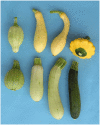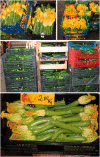Italian horticultural and culinary records of summer squash (Cucurbita pepo, Cucurbitaceae) and emergence of the zucchini in 19th-century Milan
- PMID: 27343231
- PMCID: PMC4934399
- DOI: 10.1093/aob/mcw080
Italian horticultural and culinary records of summer squash (Cucurbita pepo, Cucurbitaceae) and emergence of the zucchini in 19th-century Milan
Abstract
Background and aims: Summer squash, the young fruits of Cucurbita pepo, are a common, high-value fruit vegetable. Of the summer squash, the zucchini, C. pepo subsp. pepo Zucchini Group, is by far the most cosmopolitan. The zucchini is easily distinguished from other summer squash by its uniformly cylindrical shape and intense colour. The zucchini is a relatively new cultivar-group of C. pepo, the earliest known evidence for its existence having been a description in a book on horticulture published in Milan in 1901. For this study, Italian-language books on agriculture and cookery dating from the 16th to 19th centuries have been collected and searched in an effort to follow the horticultural development and culinary use of young Cucurbita fruits in Italy.
Findings: The results indicate that Cucurbita fruits, both young and mature, entered Italian kitchens by the mid-16th century. A half-century later, round and elongate young fruits of C. pepo were addressed as separate cookery items and the latter had largely replaced the centuries-old culinary use of young, elongate bottle gourds, Lagenaria siceraria Allusion to a particular, extant cultivar of the longest fruited C. pepo, the Cocozelle Group, dates to 1811 and derives from the environs of Naples. The Italian diminutive word zucchini arose by the beginning of the 19th century in Tuscany and referred to small, mature, desiccated bottle gourds used as containers to store tobacco. By the 1840s, the Tuscan word zucchini was appropriated to young, primarily elongate fruits of C. pepo The Zucchini Group traces its origins to the environs of Milan, perhaps as early as 1850. The word zucchini and the horticultural product zucchini arose contemporaneously but independently. The results confirm that the Zucchini Group is the youngest of the four cultivar-groups of C. pepo subsp. pepo but it emerged approximately a half-century earlier than previously known.
Keywords: Cocozelle; Cucurbita pepo; Italian cookery; Italian horticulture; Lagenaria siceraria; Summer squash; Zucchini; courgette; gourd.
© The Author 2016. Published by Oxford University Press on behalf of the Annals of Botany Company. All rights reserved. For Permissions, please email: journals.permissions@oup.com.
Figures







References
-
- Aloi A. 1899. Trattato di agraria redatto. Turin, 97–98.
-
- Anonimo Toscano. 1863. Il libro della cucina del secolo XIV. Bologna, 9, 100.
-
- Artusi P. 1891. La scienza in cucina e l’arte di mangiar bene. Florence, 30, 31, 72, 92, 120, 168–172, 201, 202, 283.
-
- Battaglia S. 2002. Grande dizionario della lingua italiana, vol. 21. Turin, 1100, 1103–1104.
-
- Bauhin J. 1651. Historia plantarum universalis, vol. 2. Yverdon, 212–232.
Publication types
MeSH terms
LinkOut - more resources
Full Text Sources
Other Literature Sources

